6.6: Three Kingdoms of Korea 57 BCE – 668 CE
- Page ID
- 232299
Introduction
After the fall of the Han dynasty in China, the area of current Korea was divided into different regions and eventually consolidated into three major kingdoms with a few independent city-states. Goguryeo, Baekje, and Silla became the primary regions, eventually forming the Korean people. Goguryeo (6.6.1) was the most prominent kingdom in the north, even controlling some of Northeast China. Baekje and Silla were in the southern part of the peninsula. The same language, culture, and politics united all three kingdoms. Buddhism was the state religion of the kingdoms, and the governments were based on a warrior aristocracy. The three kingdoms also maintained close relationships with the Chinese governments.
Goguryeo was the first kingdom to emerge when one of the different tribes defeated the opponents and declared the kingdom theirs. In the region, the line of succession for the ruling person went from brother to brother. However, as the kingdom was established, the rules for royal control were changed to father and son. Baekje was the second kingdom to be established when King Koi defeated the Chinese. The king also "declared a law that officials who accepted bribes or were guilty of extortionate practices would be required to pay three-fold compensation and in addition would be barred from office for life."[1] This law was the beginning of a written law code. In the reign of King Ch'ogo (346-375), the king was a warrior and started the tradition of warrior kings. The kingdom of Silla grew from the consolidation of twelve walled states in the area, forming a confederated kingdom. The era of the three kingdoms was a period of prosperity and continued warfare against each other and China. "The Three Kingdoms Era is a most dynamic era in which the framework for a unified culture and nation were laid."[2]
A brief history of Korea, history of korea, history of Korean kingdoms, korea three kingdoms period, Korean history, south korea history, korea, history, Gojosen, Korean dynasties, documentary, 2019, korea history crash course, ancient korea history, ancient korea, Korean history summarized, Korean history, goguryeo, ancient koea, Goguryeo histoy.
Goguryeo Kingdom 37 BCE-7th century CE
The area known as Goguryeo had several interpretations of its name, including Koguryo, Goryeo, and Koryo. Goguryeo was a translation of the Korean word high castle. Located in today's North Korea, the area has been off-limits to historians and archaeologists who study Korean art and history. Today's country of North Korea is tightly controlled and maintains strict admittance to anyone who wants to research and record images of artifacts found in the country. The Japanese also took many essential items during World War II; however, much of that art has been returned to Korea.
As the kingdom began to form and move out of Han Chinese control, they were aided in the transition by adherence to iron technology for weapons and agricultural tools. Han culture had also been part of the region, dictating how they dressed and what symbols those in control used. As the Goguryeo people gained control, they were known for their superior military forces and agricultural techniques. With territorial expansion from the first through the third centuries CE, their power grew, and the culture was more heterogeneous as they incorporated tribal regions into their control. "It is quite interesting how Goguryeo allowed its own cultivated and refined culture to meet other cultures and how Goguryeo formed a new one; it was Goguryeo society's task to develop a Goguryeo-style universal culture at the international level, a so-called pan-Goguryeo culture with Goguryeo characteristics and universality."[3]
Mural paintings from the Goguryeo period were usually located in stone mound tombs. Everyday events were frequently painted on the walls. The murals were made with lime plastered on the wall, a sketch made before the plaster dried, and color added. Later, artists allowed the lime to dry on the wall and then painted with tempera. The paintings remained intact and colorful as long as the tombs were sealed. However, after the tomb was opened, humidity, light, and even people's breath faded the colors. Artists added decorative patterns, people, or mythologies to the murals' images. One of the stone mound tombs (6.6.2) made for a general was large, with space for multiple rooms inside the tomb. The other tomb (6.6.3) was smaller, and although both tombs were built for generals, one general might be at a higher rank or was more successful in his life. Cut stones were stacked in a pyramid style to make the tomb, and the opening was high up on the pyramid. The larger tomb was seventy-five meters per side and eleven meters tall. Inside the brick or stone line, rooms were accessed by a passageway. The body of a deceased person was laid on a stone base. At some tombs, the inner rooms were covered with lime mortar and channels to drain off the water.
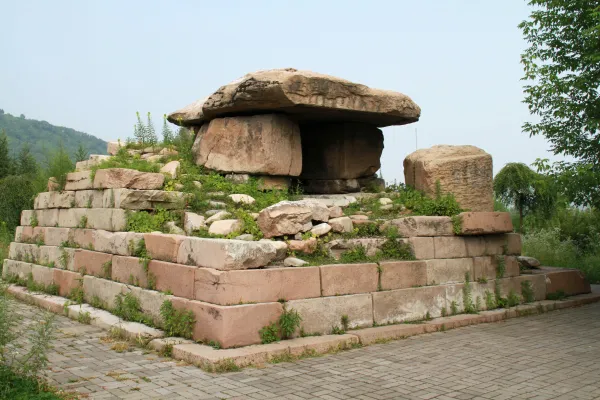
Different images were painted in the tombs. The most popular theme was the four beasts: the Blue Dragon, White Tiger, Red Phoenix, and Black Tortoise representing the four guardian deities. Historians believe the four gods were based on the four cardinal directions or the four seasons. Other common painted objects on the walls were the sun, moon, constellations, lotus blossoms, and sacred beasts. None of the objects had any standard shape; they were solely depicted as artistic expressions and might look strange. In Gangseo Great Tomb's western side ceiling (6.6.4), multiple style images are painted; the flowers might look like a lotus blossom while others are imaginary. One tomb painting (6.6.5) portrays a mix of phoenix/woman with flowers added in. In the Anak tomb number 3, one of the images (6.6.6) was not imaginary and instead portrayed an image of the deceased on the wall. Each image depicts a look at everyday life and the importance of mythology.
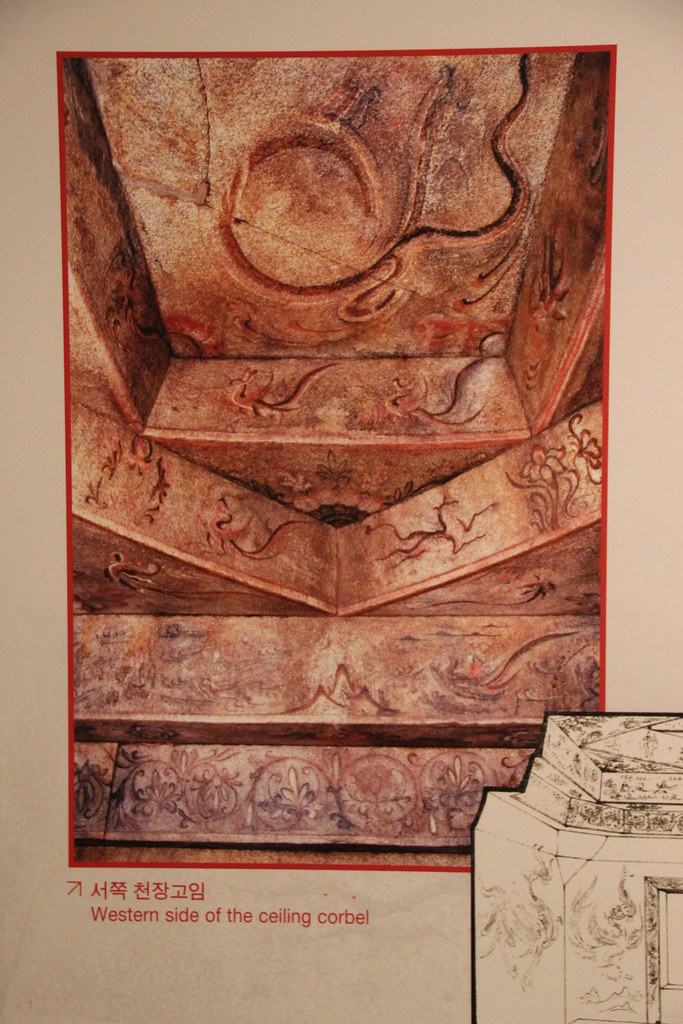
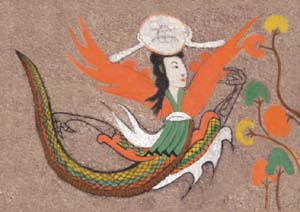
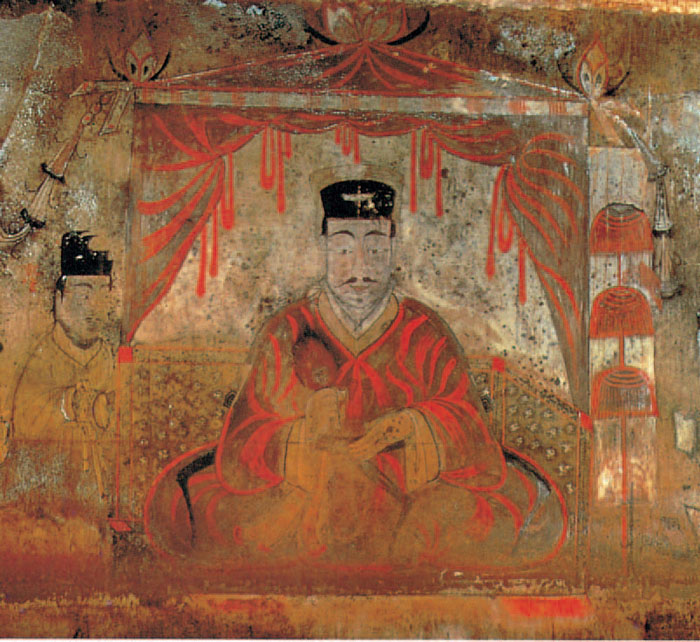
Buddhism spread from India into East Asia, including the Korean peninsula region, and took the form known as Mahayana. "One key feature of this sect is its emphasis on the attainability of salvation, and hence the importance of the bodhisattva—a compassionate being who assists mortals in the achievement of Enlightenment. Buddhist sculptures produced in East Asia often represent not only the Buddha ("the awakened one") but also a pantheon of bodhisattvas."[4] Buddhism came to Korea about 375 CE when monks from China came and disseminated Buddhist beliefs to the three Korean kingdoms. Buddhism flourished in Korea because some powerful elites and the royals supported the expansion of the religion. Eventually, Buddhism was effective in unifying the country. Monuments of large sculptures and small statues were found throughout the kingdoms. The sculpted figures (6.6.7, 6.6.8) in Baekje were made with gentle faces and pleasant proportions. Both sculptures' faces are soft and reflective; their clothing is decorative with an elegant, simple necklace.
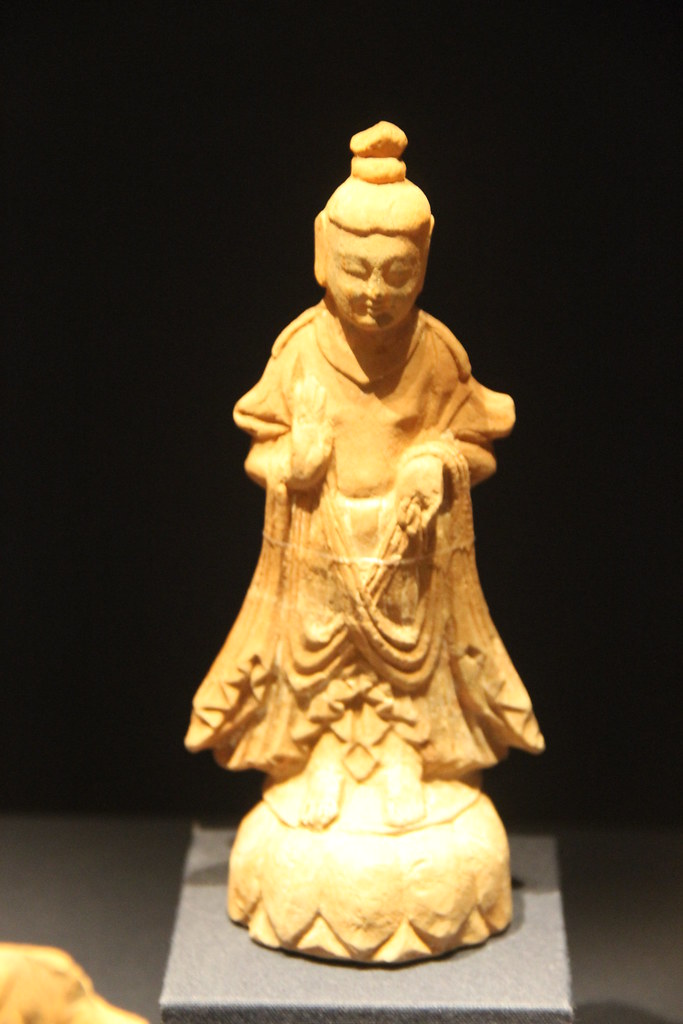
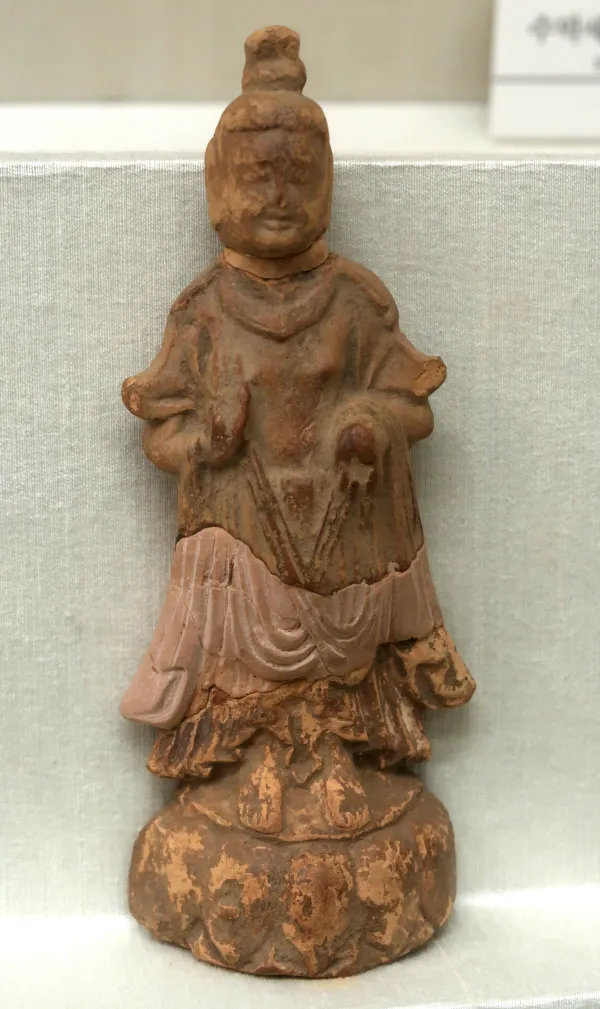
Baekje Kingdom 18 BCE-660 CE
Baekje had the largest population of the three kingdoms and was founded by the third son of Goguryeo's founder. Baekje was based on Buddhism for its political unity, cultural positions, and authority of royalty. Baekje also maintained unique relationships with Japan and introduced Buddhism to Japan in the mid-sixth century. Baekje was in the southwestern part of Korea and was influenced by Chinese dynasties' art. The kingdom also influenced Japanese art in this period. The Baekje style of Buddhist sculpture is quite different and an unusual Korean style. One of the unique characteristics was the "Baekje smile." The sculpture (6.6.9) was more natural and less stylistic, portraying naturalness and friendliness. The statue has the characteristic Baekje smile. The Standing Buddha Reborn (6.6.10) was carved from a rock wall. Buddha stands in the middle with a bodhisattva on one side and an image of Bangasayusang on the other. The Buddha has the typical smile, as do both attending figures. Behind Buddha's head is a ring of lotus flowers, flame patterns, and inscriptions, forming a halo-like headdress. When the sun shines on the figures, their smiles change.
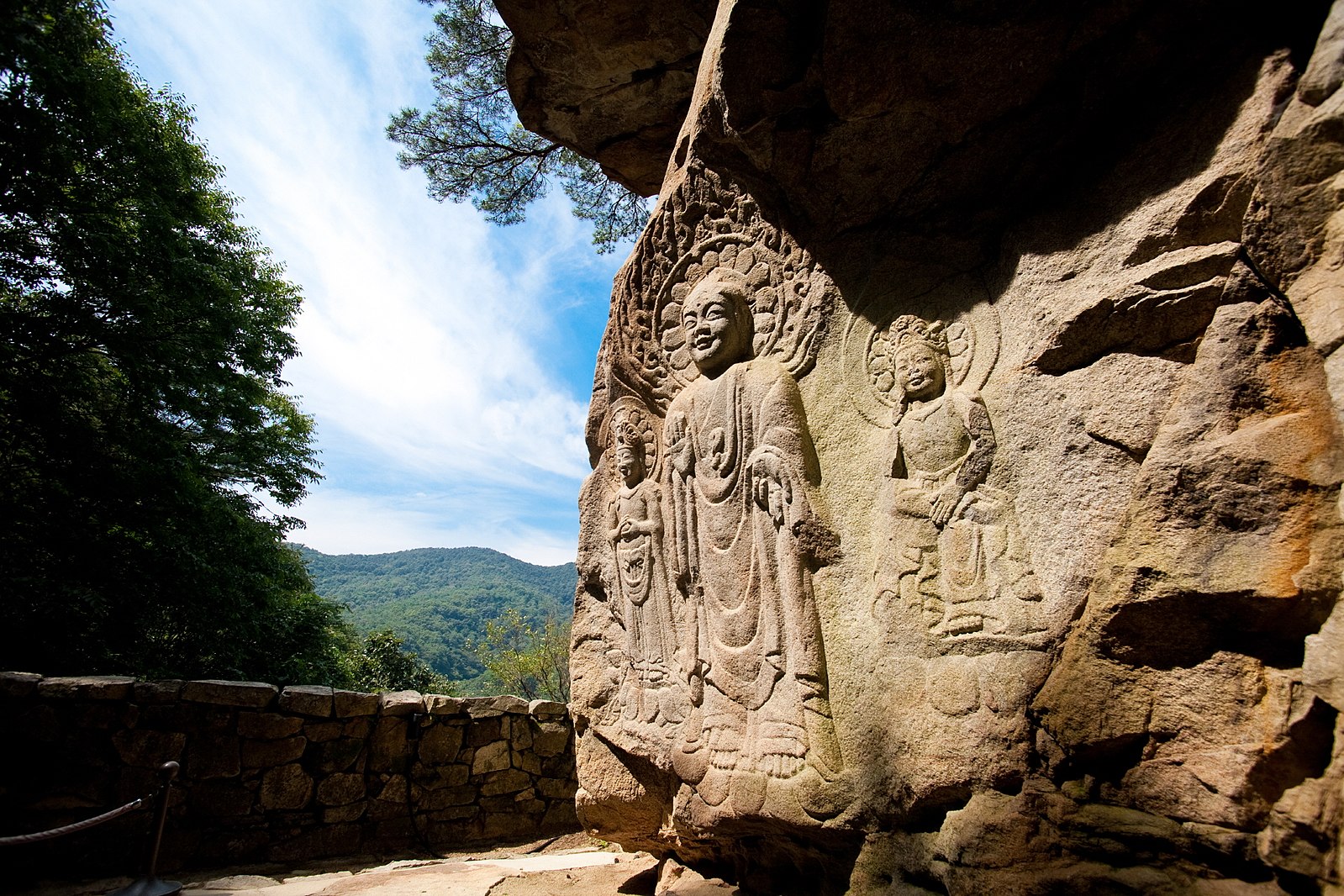
Wooden buildings did not survive through time and weather; however, the five-storied stone Jeongnim-sa Pagoda (6.6.11) did last through the ages and is an example of how other buildings were built. The pagoda was constructed during the Baejke period and made of stone on a narrow and short base. "Pillar stones are fixed into the middle and corners of each side of the pedestal. Pillars in the 'Beheullim Technique' (narrow at the upper and lower part and convex at the middle in a pillar) stand at each corner of the pagoda body in each story. Roof stones are thin and wide and raised at the end of the eaves to look nimble."[5] The pagoda is inscribed with information about the Baekje victory over the Tang dynasty. Wooden pagodas were probably made with the same characteristics.
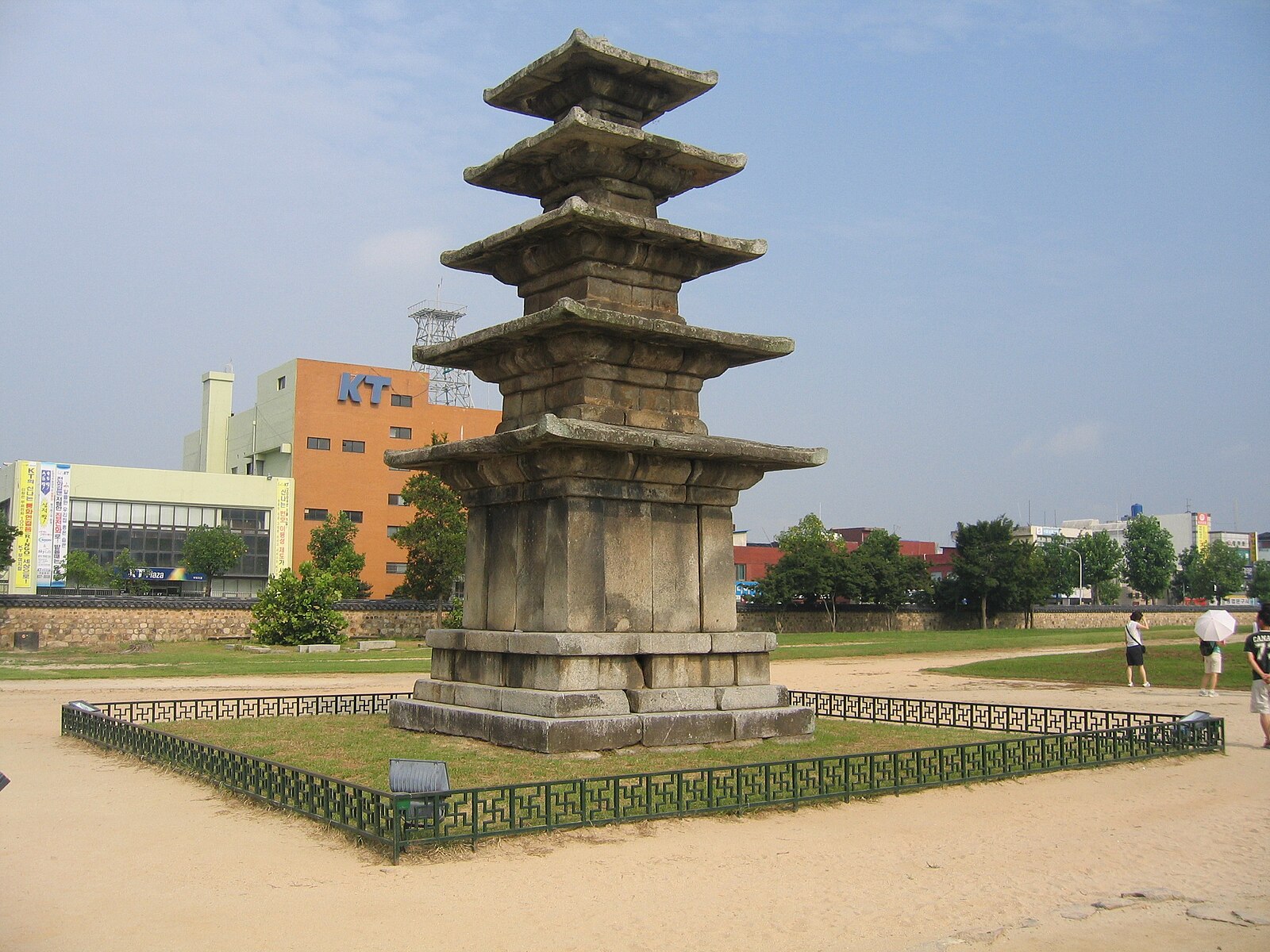
King Muryeong ruled Baekje from 501-523 CE and was buried in a tomb that was never looted and not discovered until 1971. The tomb appeared as mounded dirt (6.6.12) and was 20 meters across. The tomb was brick with an extensive drainage system to keep the moisture out. Many of the bricks making the tomb were embellished with lotus blossom designs and other motifs. The king was found in the eastern part of the tomb, and the queen in the western half. Because the tomb was never looted and the drainage was good, archaeologists found a treasure of artifacts, including multiple items of gold. The king and queen were buried in wooden coffins (6.6.13) made from umbrella-pine lumber found in Japan, demonstrating the vast trade network. Much of the wood in the coffins was rotted away; however, many of the nails and decorations were left, and historians could recreate the coffins as seen in the image. The king's coffin was larger, taller, and more ornate than the queen's coffin. Both coffins were embellished with gold images.
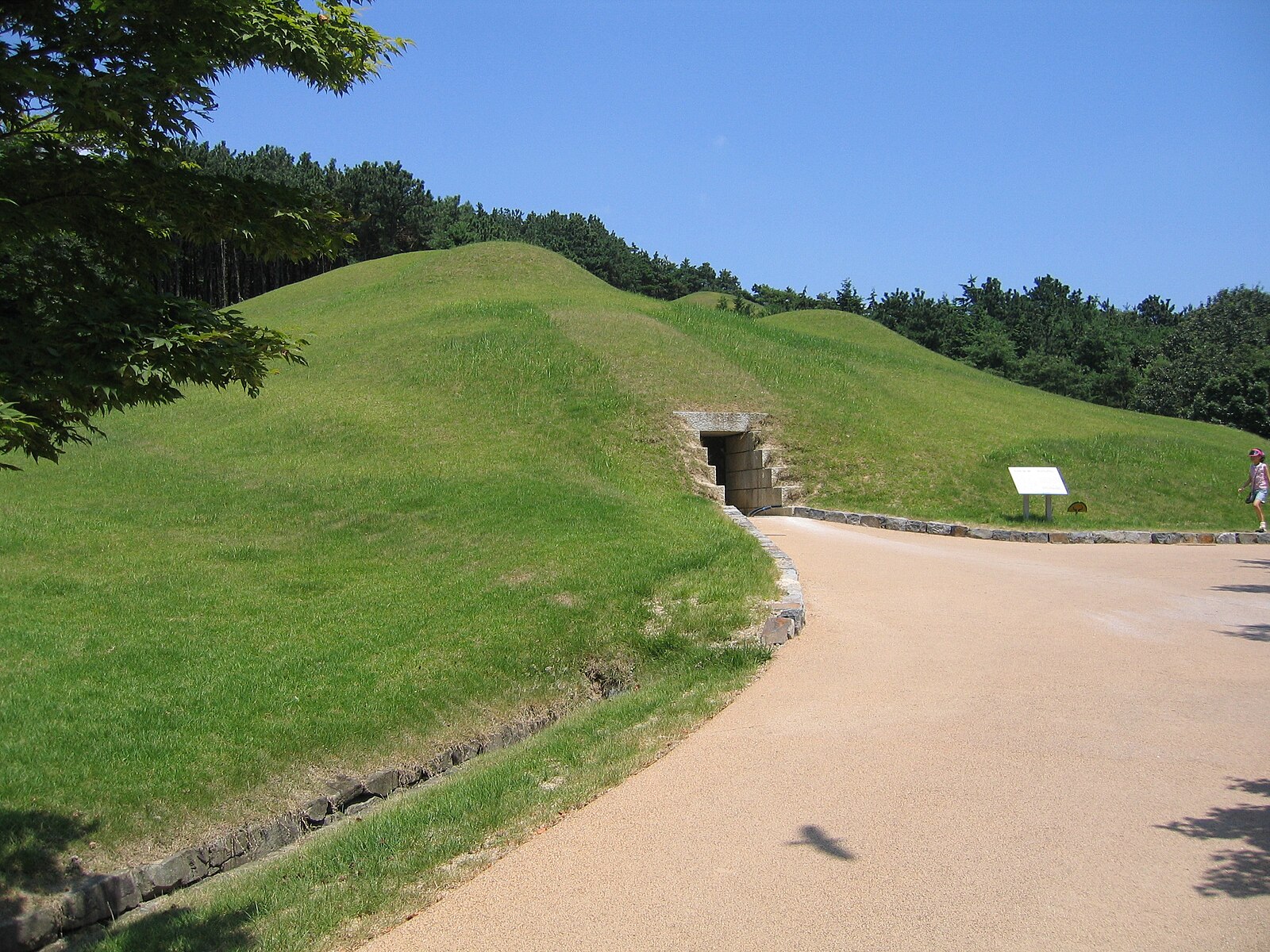
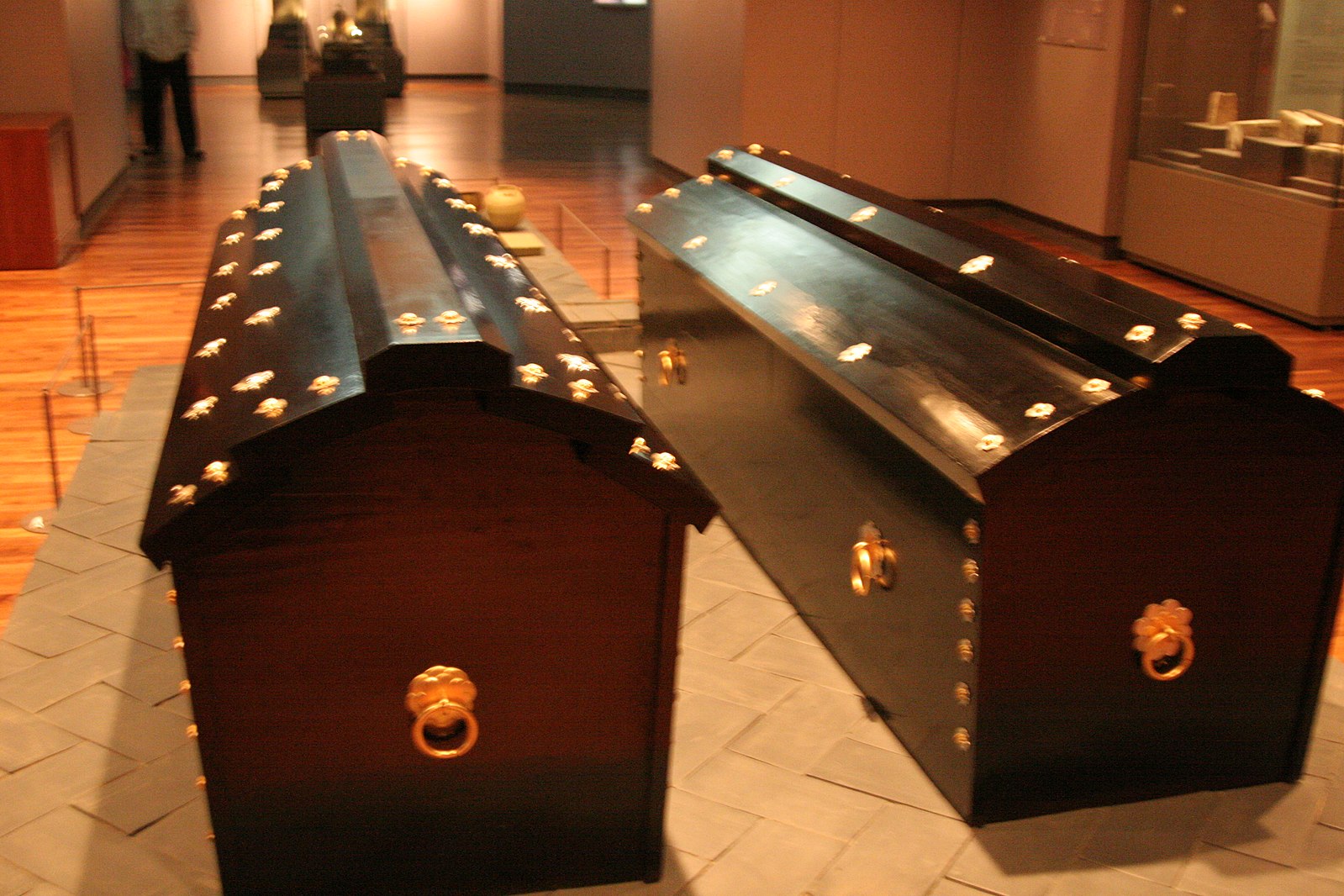
The king's sword (6.6.14) was found next to his waist. The sword had a ring-shaped pommel, indicating the prestige and social status of the king. The sword featured a dragon's image, a sign of great power. Another symbol of the king's power was the gold diadems (6.6.15) found in the tomb near the king's head in his coffin. The diadems were cut from extremely thin gold and were presumed to be attached to the king's royal cap. This set of diadems appears as vines or branches with flowery patterns. After finishing the gold design, gold spangles were added to the diadems. The queen had a similar set of diadems as the king; however, her set did not have gold spangles. "According to written sources, the Baekje king wore a black silk cap decorated with gold flowers, while members of the government who were ranked nasol (sixth rank) or higher wore black silk caps with silver flowers. Thus, based on the written records and the site's location, it is estimated that these crown ornaments would have been inserted into black silk caps."[6]
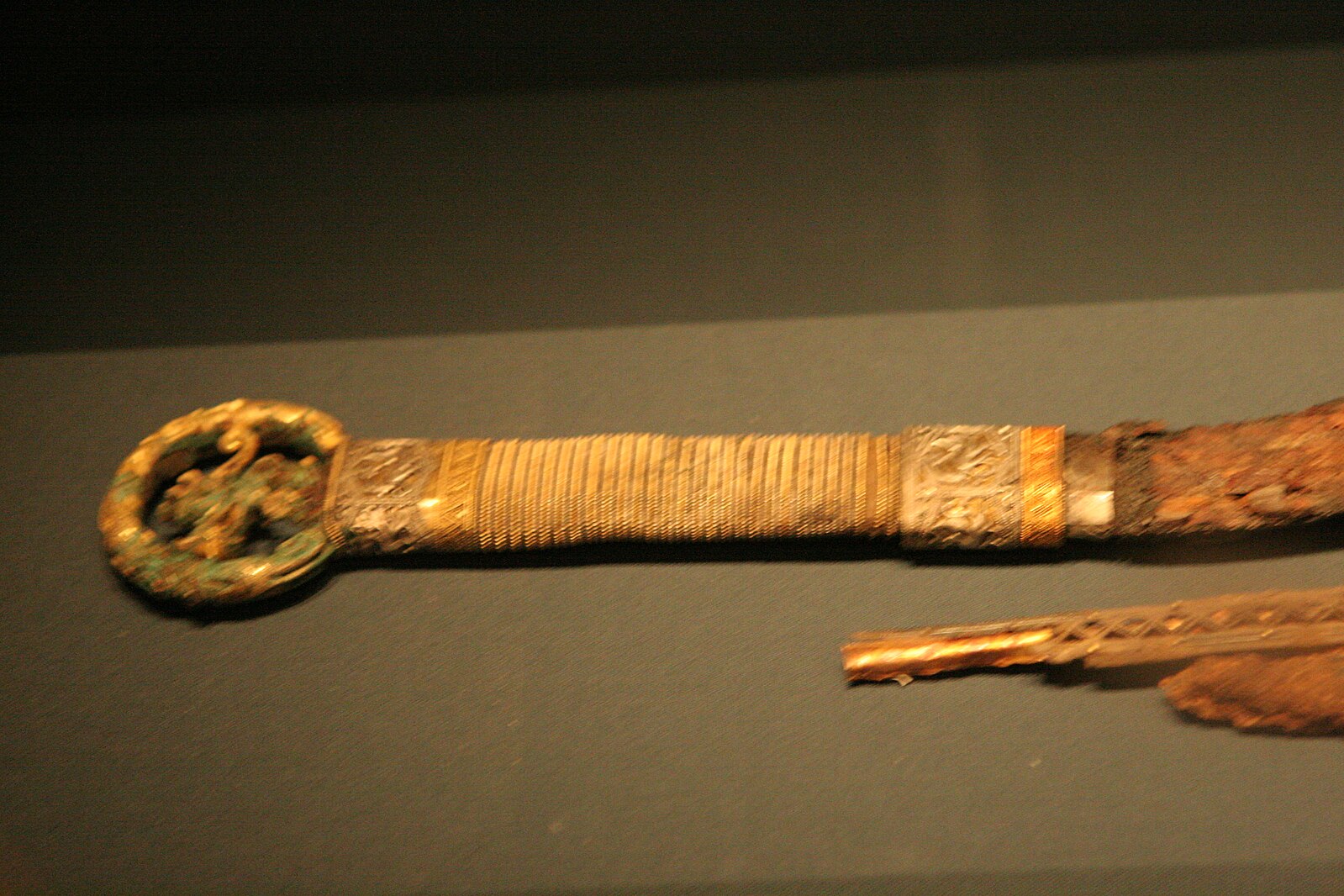
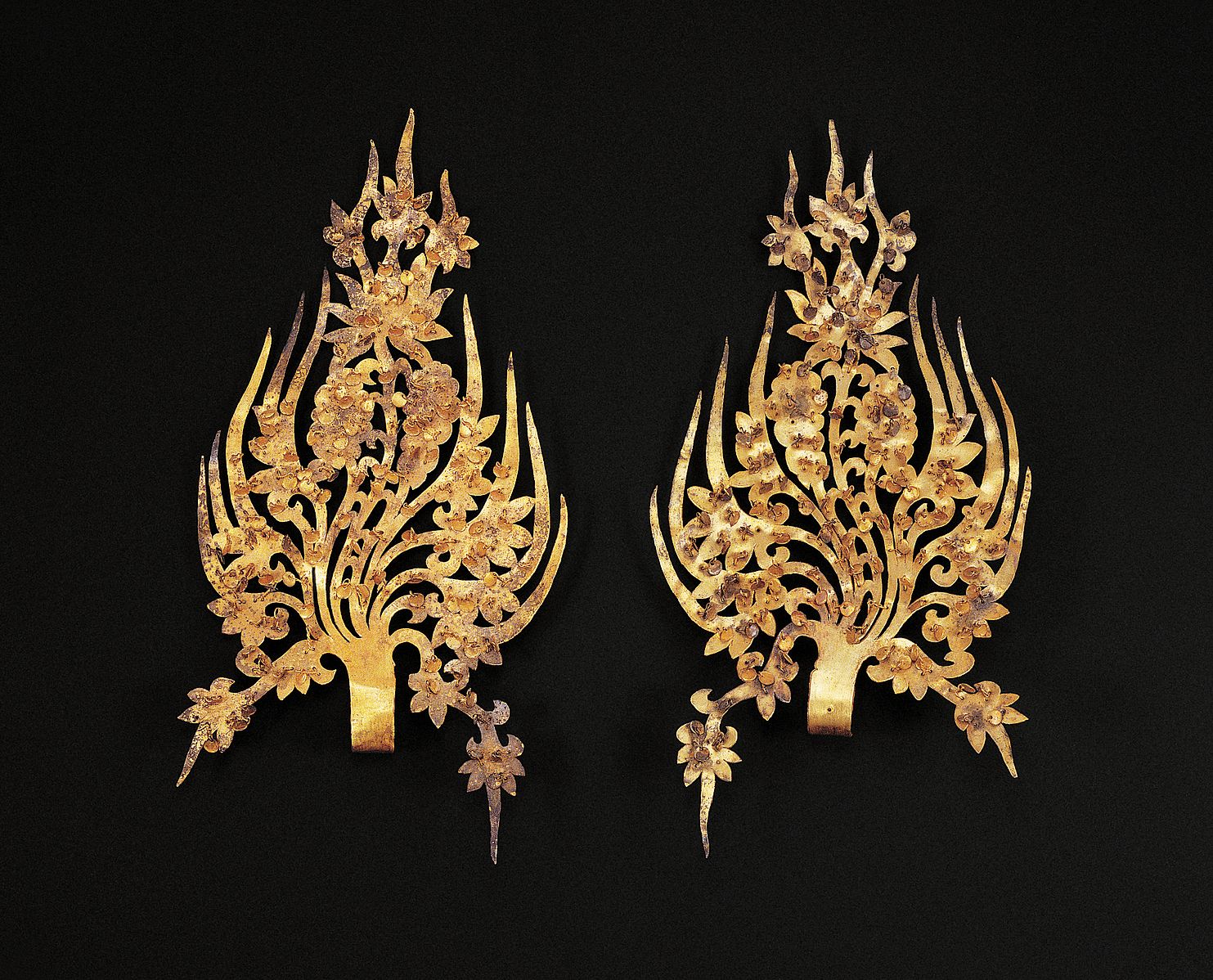
Gilt-bronze objects were commonly made in Korea. Bronze by itself corrodes over time and turns green. However, if gold is added, the gold still shines after a long time. Two different processes were used to make gilt-bronze objects: gold-mercury amalgam or mercury-gold leaf gilding. Both methods are dangerous because mercury gives off toxic fumes, and the process is no longer used today. The gilt-bronze incense burner (6.6.16) portrays animals in mythology or from distant places, starting with the phoenix sitting on top of the incense burner. The Enlightenment is represented by the mountains embellished with animals and people who look like animals. "The water, symbolizing life, is expressed as a dragon, and the lotus flower base is blooming from a dragon's mouth with five legs, which appear like splashing waves. The dragon in our culture is an animal that symbolizes water, said art historian Han Jeoungho."[7]
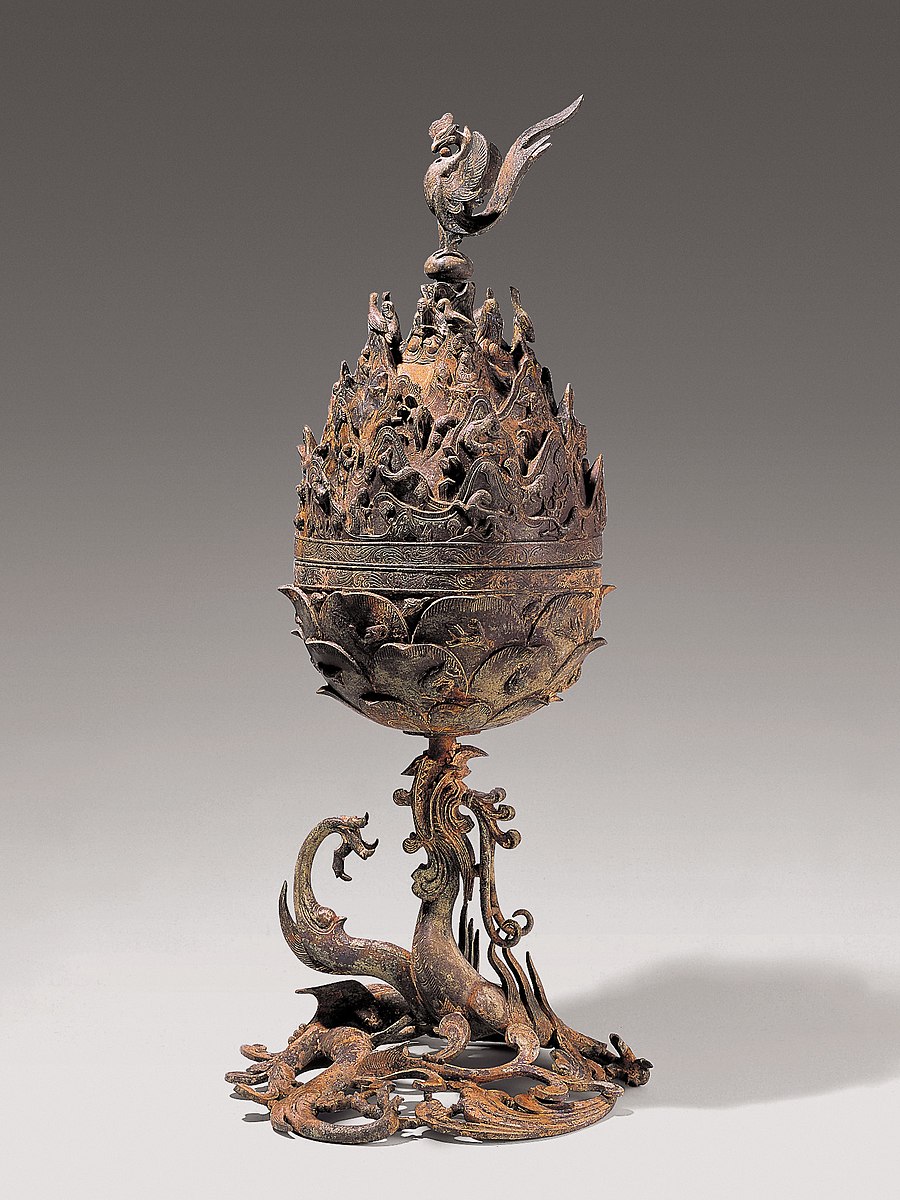
Silla Kingdom 57 BCE-935 CE
Silla was a country known for its gold and as a cosmopolitan kingdom that started small and, with the help of the Chinese Tang dynasty, eventually gained power over most of Korea by the end of the seventh century. Leadership was based on a strict hereditary system, and the period became the Unified Silla period. Buddhism was the official religion, leading to the construction of magnificent temples and religious sculptures. Art flourished in Silla and was essential to influencing art and technology in Japan.
The Bulguksa Temple was initially built as a small wooden temple in 528 CE as a local temple. However, in 751 CE, the court wanted something worthwhile to dedicate to ancestors and started constructing the current structures. The temple was destroyed and rebuilt in different periods; however, some stone constructions survived. Two ancient stone pagodas stand at the site; the Seokgatap Pagoda (6.6.17) is based on a simple design with little adornment and represents a general-type stone pagoda, and the ornate Dabotap Pagoda (6.6.18). Both structures are 10.4 meters high and face each other. The Seokgatap Pagoda is considered a three-story structure and stands on a two-story base, and although simple, it is an example of perfect symmetry and proportion. The number of stories in the Dabotap Pagoda is uncertain because of the placement of each section and the additional pillars, guardrails, and decorations.

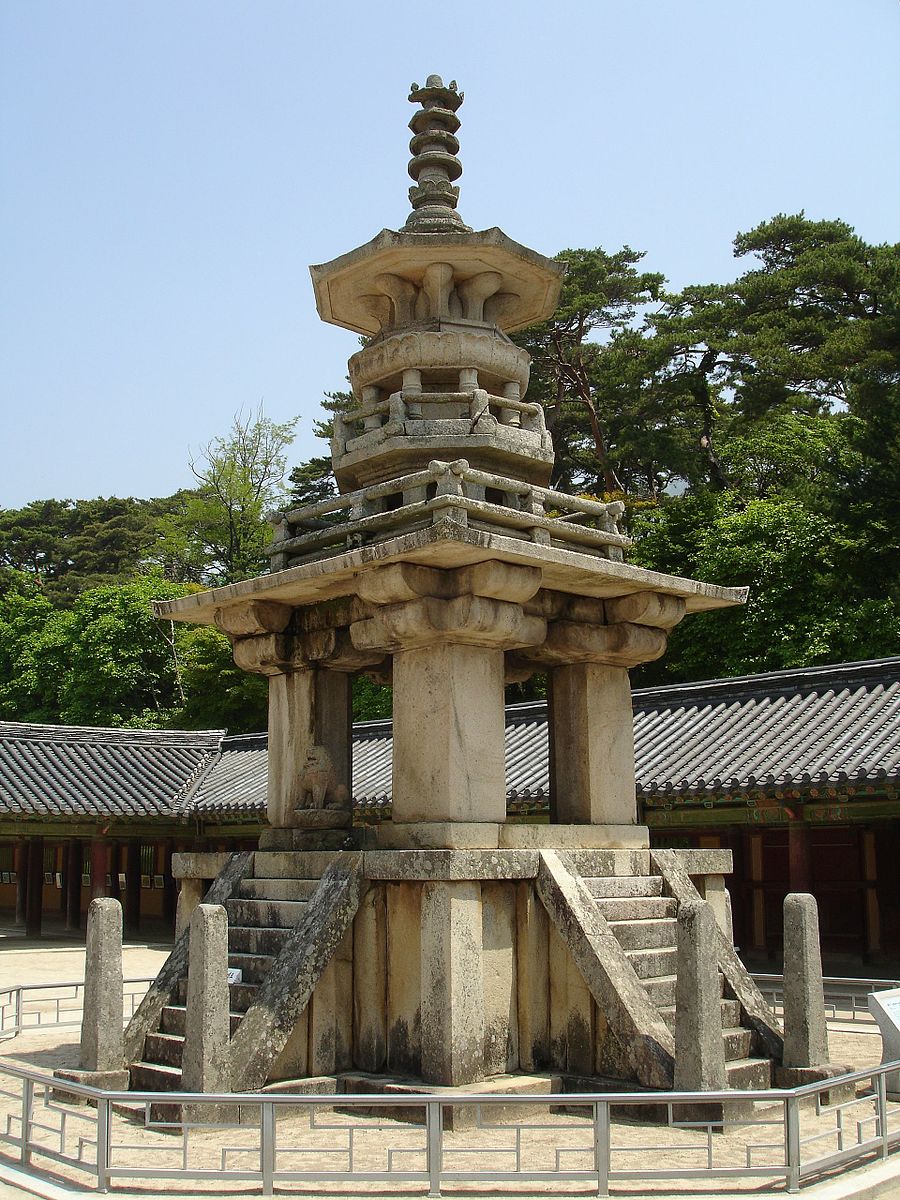
The Bulguksa Temple has two areas, each marked by a set of bridges. The Cheongungyo Bridge (Blue Cloud Bridge) and Baekungyo Bridge (White Cloud Bridge) (6.6.20)lead to one hall, and the Yeonhwagyo Bridge (Lotus Flower Bridge) (6.6.19) and Chilbogyo Bridge (Seven Treasures Bridge) lead to the other hall. The region below the stairs is considered the human world, and the space above the stairs belongs to Buddha's world. The bridges are a symbolic entrance from the human world to the spiritual. The bottom part of the bridge has a rainbow-shaped arch and a forty-five-degree slope. Initially, there were carvings on the steps which have faded from the traffic of footsteps. Today, the bridges are restricted to preserve them. The Cheongungyo and Baekungyo Bridges are made with thirty-three steps. The concept of thirty-three depicts the thirty-three heavens in Buddhism. The term bridge has a different connotation to Western readers than Asian readers. The stairs form a symbolic "bridge" between heaven and earth.
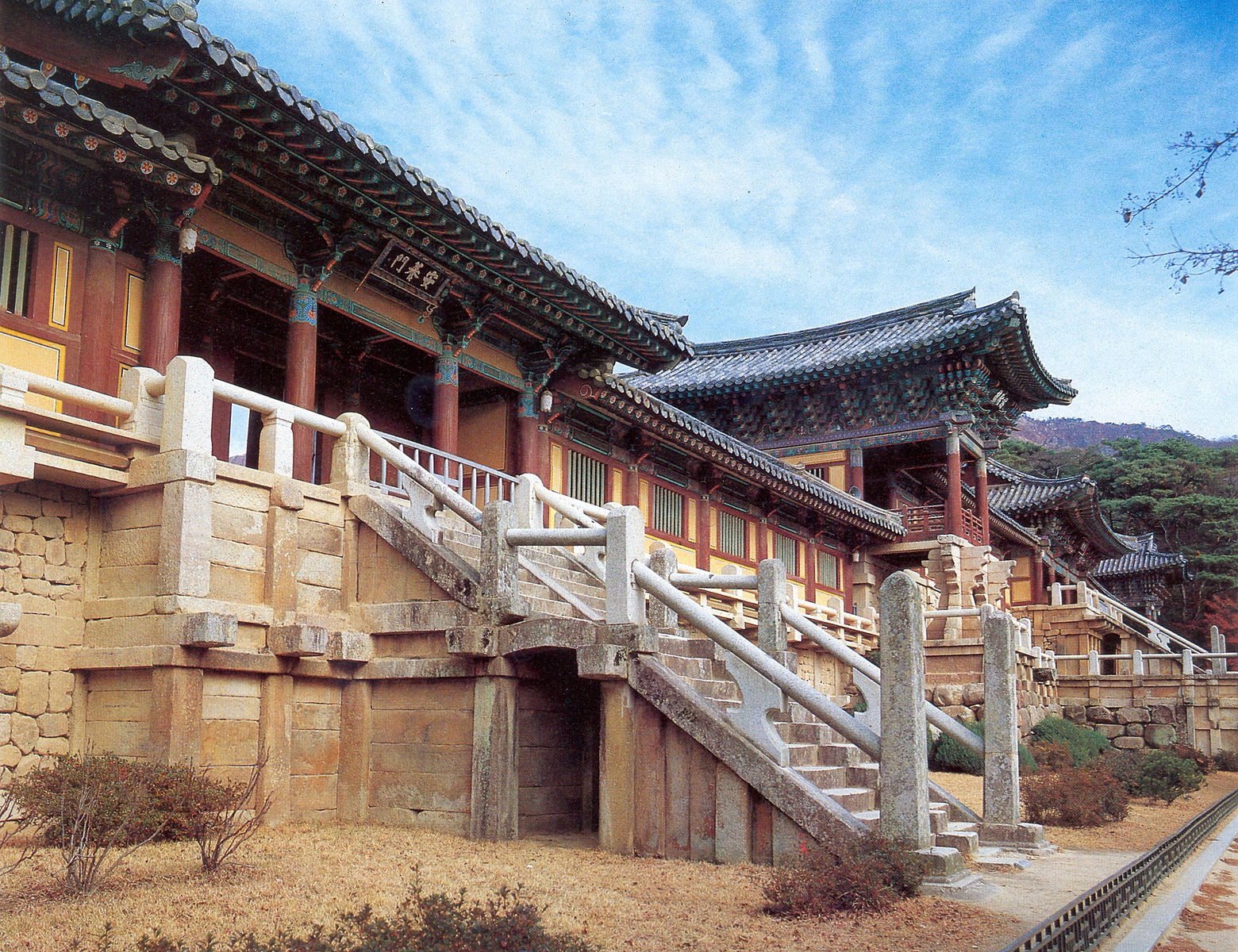
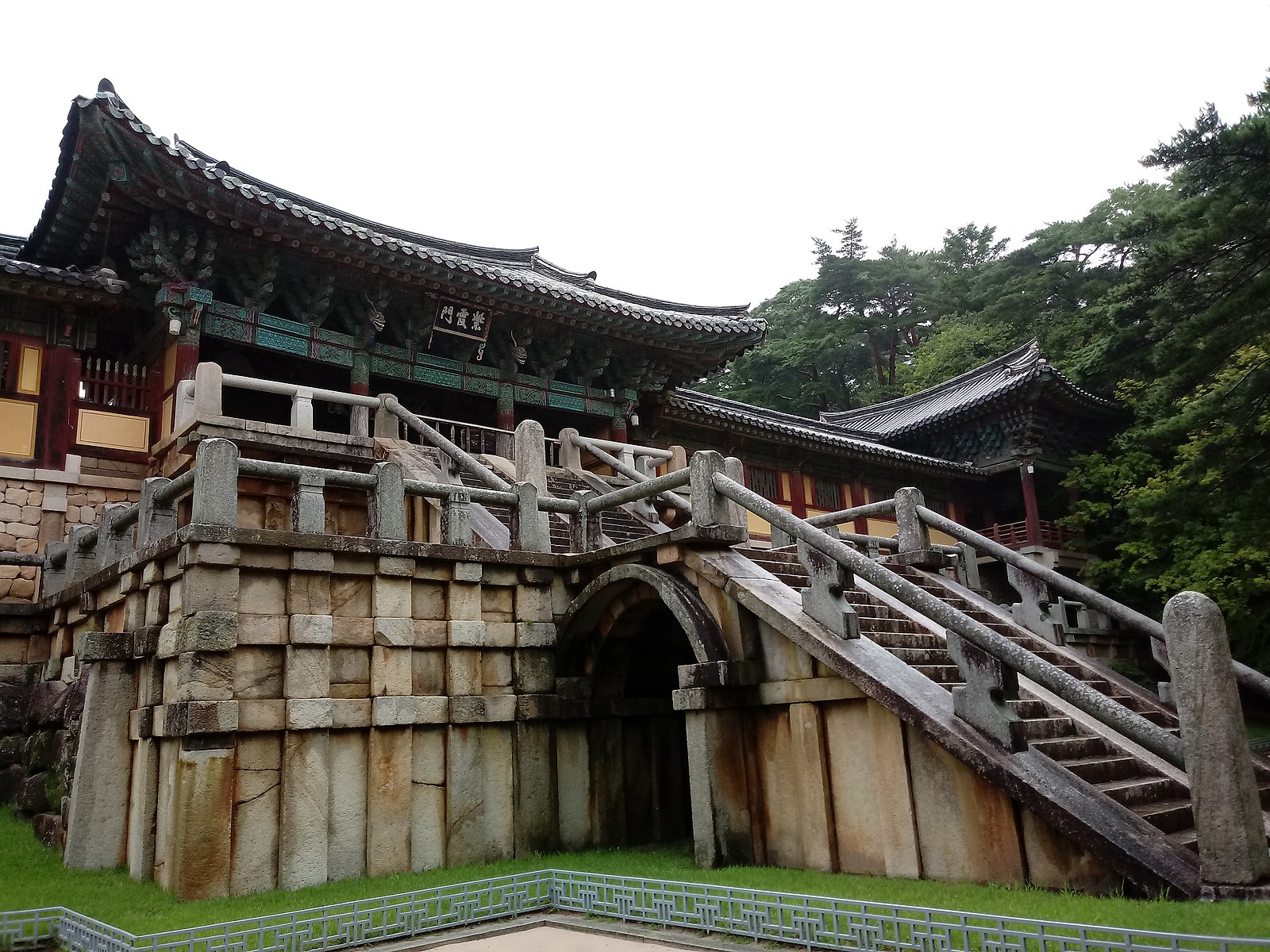
Seokguram is an artificial grotto made from large blocks of granite quarried in a nearby mountain, and dirt was piled on top of the structure to form a natural-looking mound. "The structure shows Silla people's belief that the heavens were round, and the land was square."[8] The grotto was constructed during the Unified Silla period between 751 and 774 CE and is considered one of the masterpieces of Buddhist art. The grotto has a front chamber (6.6.21), a hallway, and the central rotunda where the Buddha is seated (6.6.22). The Sakyamuni Buddha is placed on a round pedestal and looks east to the sea. Following the dhyana mudra pose, his right hand is in the earth-touching position, and his left hand is laid on his thigh in a position of concentration. When the sun rises, its light strikes the statue on its forehead. Behind his head is the traditional lotus halo. Around the rotunda are forty-one images of bodhisattvas and disciples sculpted in high and low relief from white granite. Time and weather have taken a toll on the grotto and carvings, and recent efforts have tried to improve drainage to reduce the damage caused by mildew and high humidity.
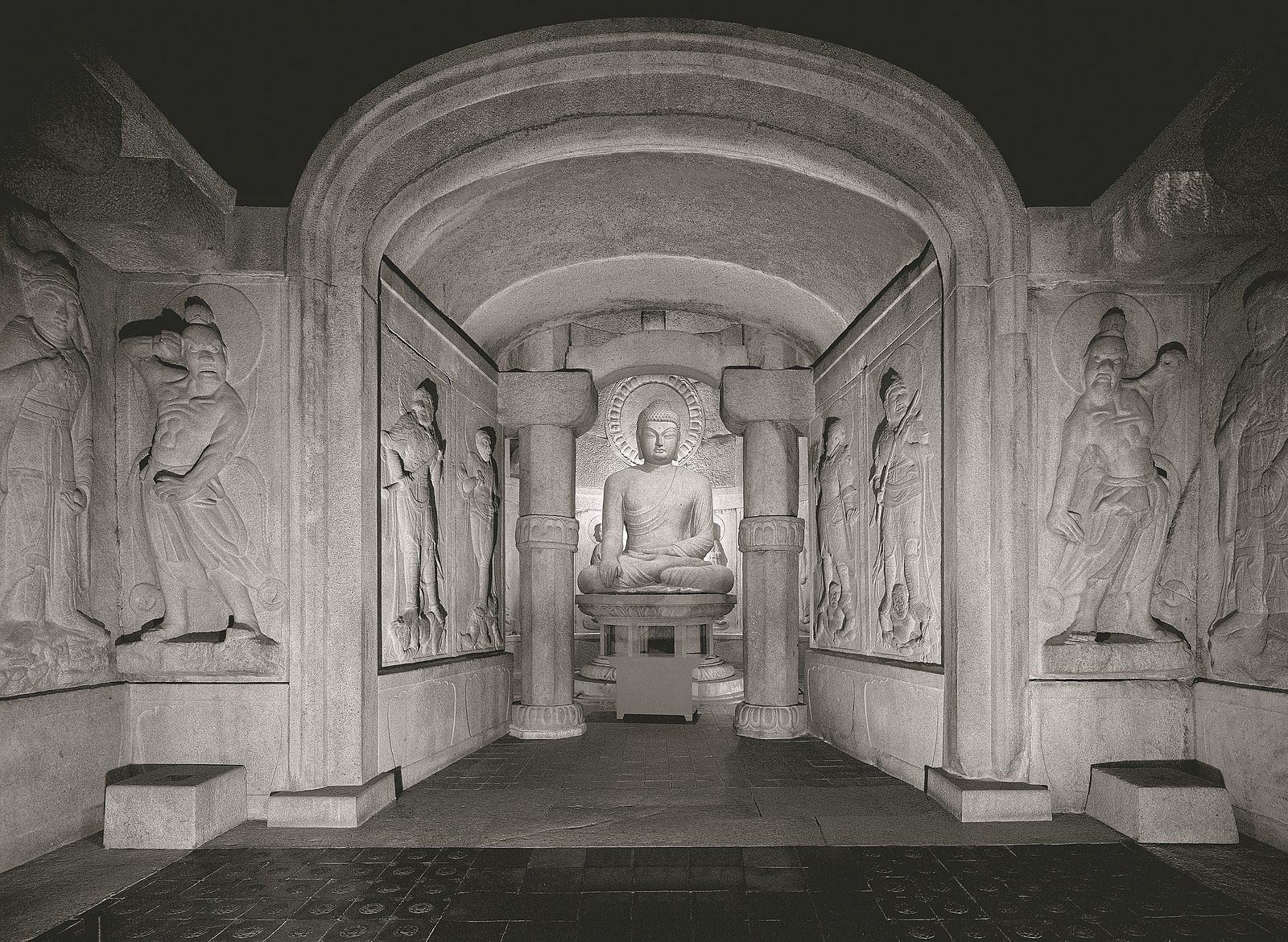
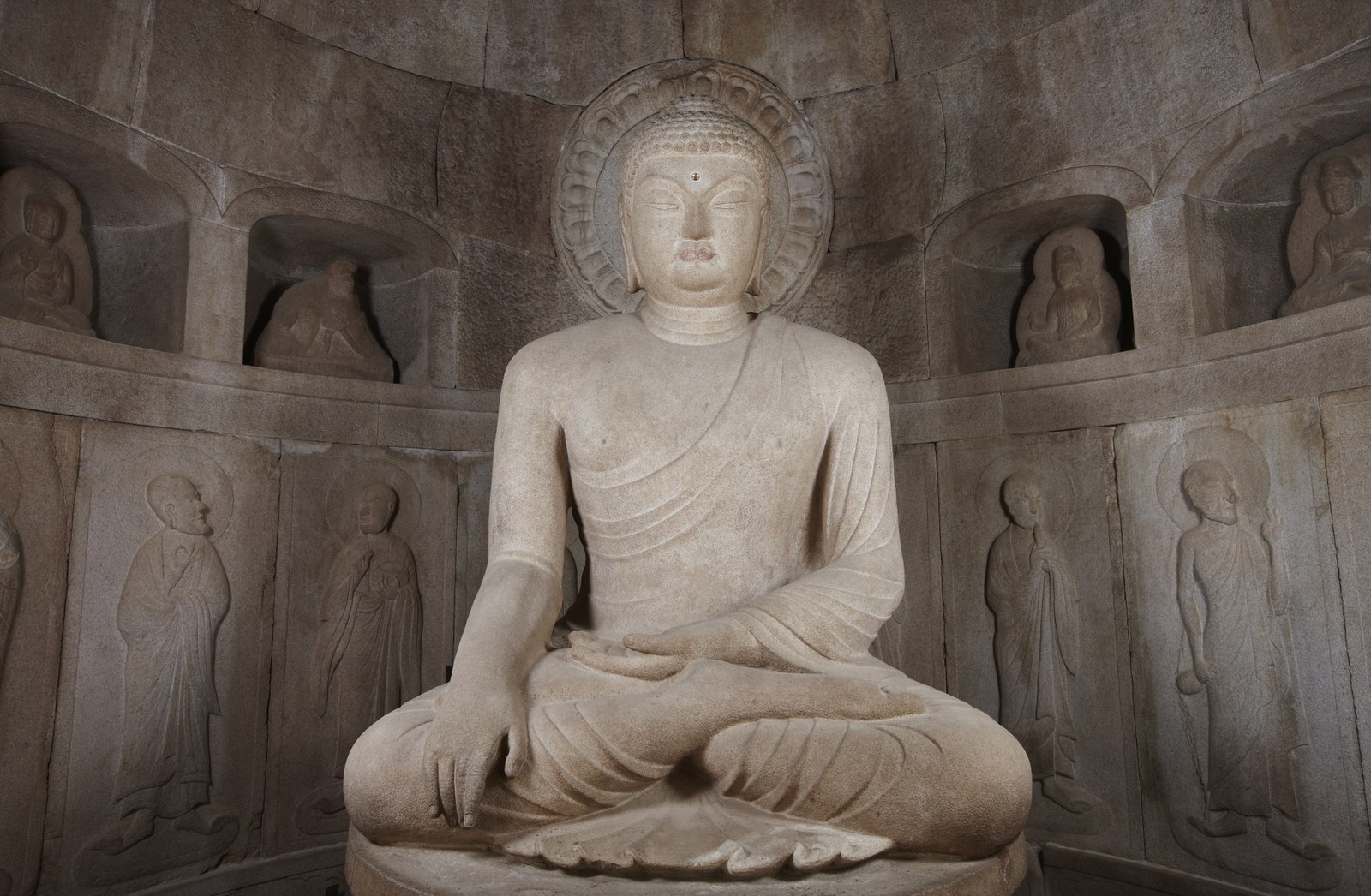
Buddhist sculpture in the Silla kingdom demonstrated the cosmopolitan society. Silla monks traveled along the trade routes, learned about the multiple styles of Buddhism, and reflected the concepts in their sculptures. The Silla statue (6.6.23) has a round face, dreamy looks, and a curvaceous body, presenting a feeling of sensuality. The bodhisattva's right leg is crossed over the left as he rests his fingers on his cheek. The style of pose was popular at the time and known as the "pensive pose." "Unlike Buddhas, the ultimate enlightened beings who have transcended mortal concerns, bodhisattvas have chosen to remain accessible to help and guide others in the phenomenal world. Particularly in Korea and Japan, bodhisattvas in the "pensive pose" are usually identified as Maitreya, a bodhisattva in the cosmic era who will become the teaching Buddha of the next great period of time. Maitreya was one of the more popular bodhisattvas in East Asia from the fifth to the seventh century."[9]
The Silla were known for the distinctive bells with a deep, far-reaching sound. The bells are uniquely cast in the shape of a barrel and ending in a rhombic shape to enhance the sound. The Divine Bell of King Seongdeok (6.6.24) is Korea's most significant surviving bell. It stands 3.75 meters high and weighs 18.9 tons.[10]The top of the bell has a tubular sound pipe to help reverberate the sound. The bell is inscribed with over one thousand Chinese characters describing information about how the bell was cast and other details. Different low-relief patterns cover the rim and shoulder.
People in Silla were buried in deep pits lined with wood and then covered and sealed under piles of dirt so grave robbers did not find the Silla treasures. Goguryeo and Baekje had corridors and hallways to the tombs, leaving them susceptible to theft. In the Silla kingdom, gold was a significant component of artistic objects, especially the crowns for royalty. The crowns were placed in the grave of the wearer upon death. Gold objects, belts, bracelets, and earrings were added to the grave. The crowns appear exceptionally fragile and were initially perceived to be grave goods. However, historians today have enough research to know the crowns were also used in ceremonial rites.
Gold crowns accentuated the power of the wearer. Each of the crowns (6.6.25, 6.6.26) are similar, representing the style of the time. The crowns were constructed to be worn around the forehead like a headband. The headband was lined with leather or silk to fit on the head and protect the metal. Each crown was heavily ornamented with branch-like protrusions covered with tiny gold discs and pieces of jade called gogok (6.6.27).The small parts of the crown were assembled using wires. The tree branches represent fertility, while the jade ornaments exemplify ripe fruit on the branches. Light shining on the crowns must have been spectacular to see.
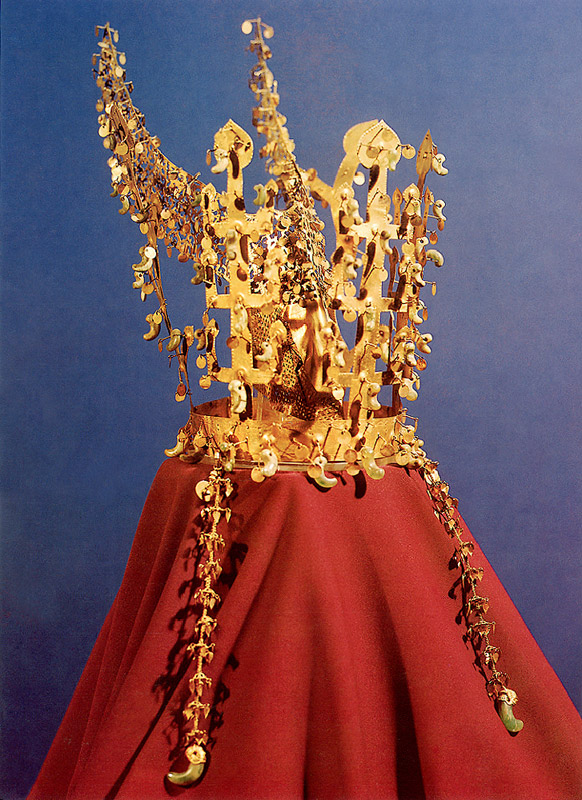
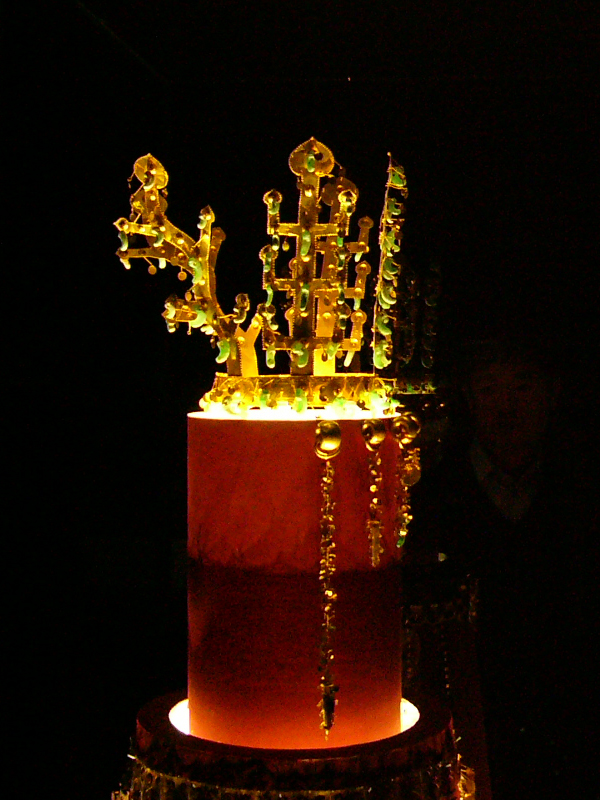
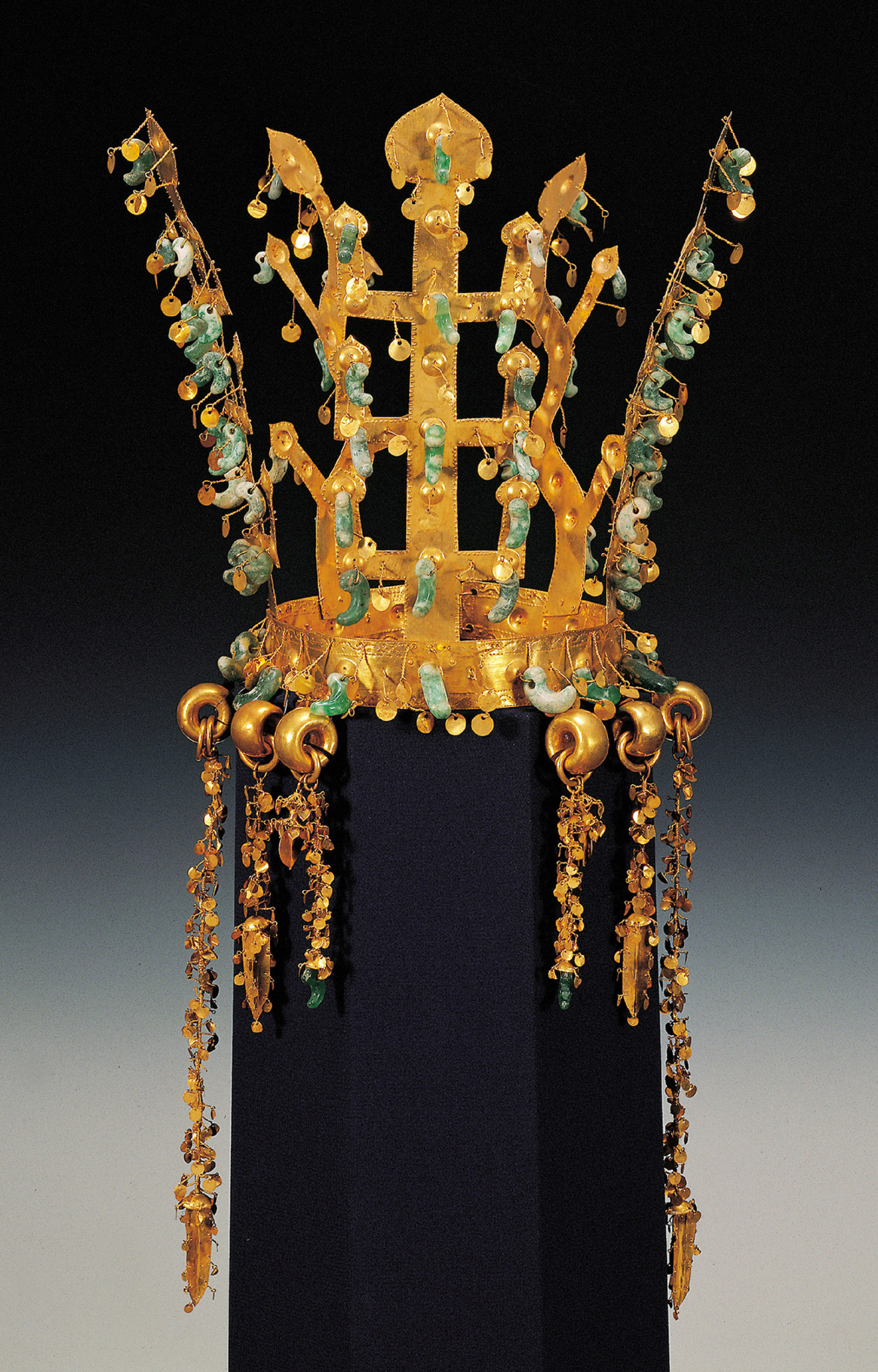
Most of the pottery from the Three Kingdoms period was usually functional. The stoneware (6.6.28) was fired at very high temperatures (800-1000 degrees C) from kilns similar to those producing iron. Many kilns were built into the hillsides and called a tunnel or climbing kiln. Shelving to hold to stoneware was cut into the slope of the hill, and the chimney was also positioned up the slope. Glazing was not part of the process. Much of the pottery was used to hold food; however, they also created pottery based on animals, humans, and even small houses. When archaeologists excavated tombs, they found pottery holding food for the deceased use in the next life. Those pots with lids were gray, unglazed stoneware (6.6.29) used to hold cremated remains and specially made for burial rituals. Pottery stands (6.6.30) were created in all three kingdoms; however, they became a specialty item in the Silla kingdom. This stand was made as a lamp with oil in the channel connected to each cup. Rows of cutout geometric shapes decorated the stand.
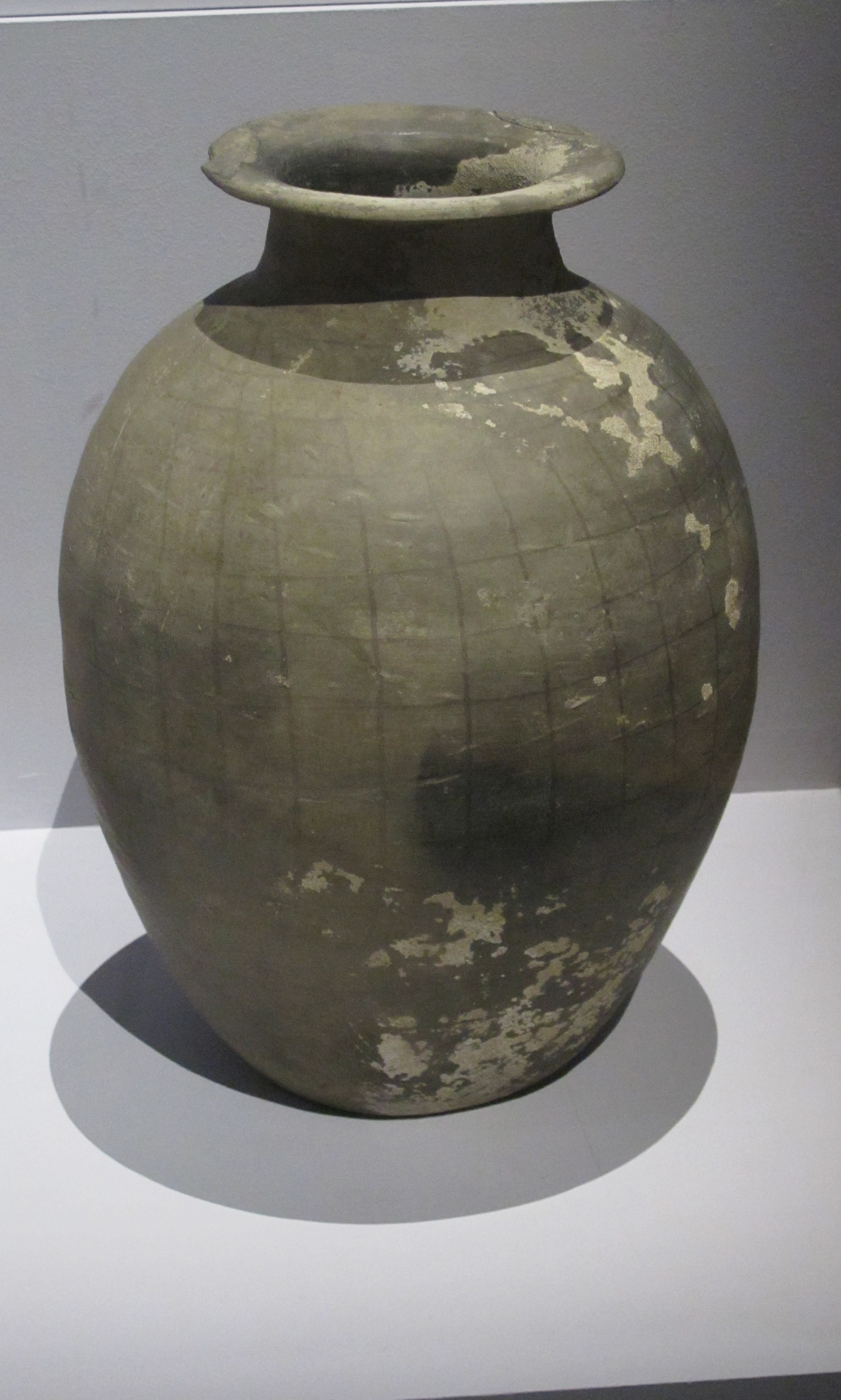
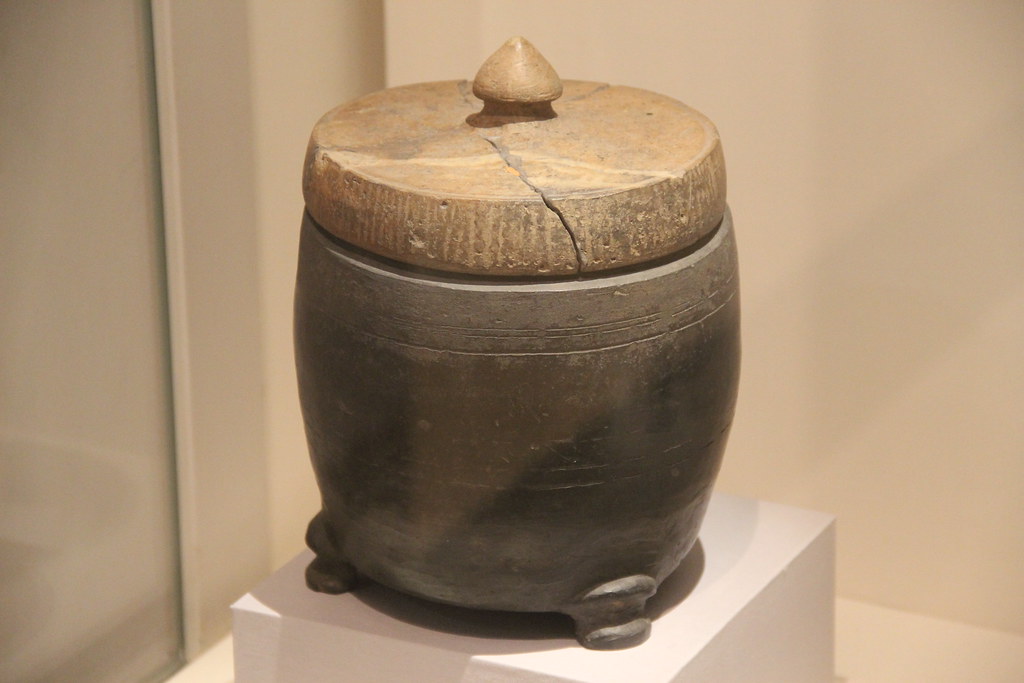

[1] Retrieved from https://academic.mu.edu/meissnerd/3kingdom-korea.html
[2] Retireved from https://academic.mu.edu/meissnerd/3kingdom-korea.html
[3] Ho-tae, J. (2005). The Review of Korean Studies, Goguryeo Culture and Mural Paintings, Vol. 7, No. 4: 11-34. Retrieved from https://accesson.kr/rks/assets/pdf/7...nal-7-4-11.pdf
[4] Retrieved from https://www.metmuseum.org/toah/hd/kobs/hd_kobs.htm
[5] Retrieved from http://www.chungnam.go.kr:8100/engli...rt_dt=&end_dt=
[6] Retrieved from https://smarthistory.org/crown-ornam...king-muryeong/
[7] Retrieved from https://www.koreaherald.com/view.php...20210909000454
[8] Retrieved from http://world.kbs.co.kr/special/unesc.../e1.htm?lang=e
[9] Retrieved from https://www.metmuseum.org/blogs/now-...nsive-treasure
[10] Retrieved from http://english.visitkorea.or.kr/enu/...jsp?cid=804389

